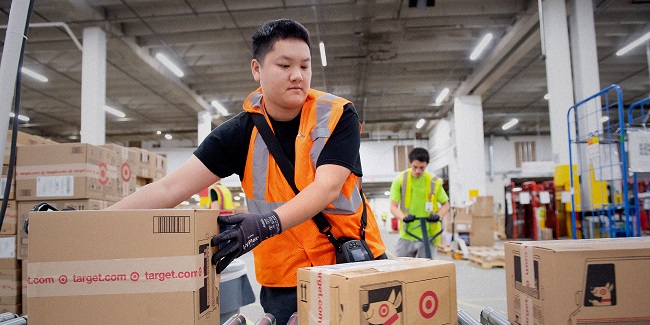Target plans to invest $100 million to expand its supply chain sortation network to more than 15 facilities by the end of 2026, bringing its next-day delivery capabilities to major U.S. markets. Sortation centers and the company’s last mile delivery capabilities are expected to deliver orders more efficiently and faster, at a lower cost while increasing capacity.
Target currently has nine sortation centers in Minnesota, Texas, Colorado, Illinois, Georgia and Pennsylvania. That includes three most recently opened facilities in the greater Chicago and Denver metro areas. With this $100 million investment, Target plans to build more than a half dozen additional facilities and create hundreds of new jobs in local metro areas with market-leading wages.
Bigger, faster, better than before: These moves demonstrate the transformative power of the company’s stores-as-hubs strategy, which leverages Target’s store network as a launchpad for online orders. Sortation centers represent the next phase, ensuring faster delivery for guests, saving shipping costs and fueling long-term company growth.
“Now more than ever, our guests rely on us to deliver their everyday essentials and Target favorites when they want and need them most,” says Gretchen McCarthy, Target’s chief global supply chain & logistics officer. “Through our sortation centers and Target Last Mile Delivery capabilities, we’re able to move faster and with more precision — while controlling costs and expanding our network capacity — for years to come.”
Count the benefits
Target piloted its first sortation center in Minneapolis in 2020, sorting online orders efficiently and quickly for delivery to local neighborhoods by a third-party carrier or Shipt delivery route, depending on the lowest-cost carrier option.
Doire Perot, operations director for the retailer’s Minneapolis sortation center, has seen firsthand how her team, the facility and its operations have evolved over that time.
“We learned that we had to operate differently,” says Doire. “This type of building, the type of next-day delivery capabilities that we can offer to our guests and team, it was going to take a different operating model across every team involved.” But the why of the strategy has not changed, she says.
“There are three high-level goals that existed on day one and still hold true today: decreasing costs, increasing speed and increasing last-mile capacity,” says Doire. “Those three things are going to be the tune for the next several years as we continue bringing that vision to life.”
Since opening its first sortation center, Target has seen multiple benefits for the retailer and its guests.
For guests, it means getting online purchase that much faster. The company’s sortation centers delivered 26 million packages to guests in 2022. Up to 40% of Target Last Mile Delivery orders with Shipt arrived at guests’ doorsteps the next day. Those numbers will increase with time.
In partnership with Shipt, Target has expanded options for drivers to take advantage of larger routes where they can use larger-capacity vehicles that can hold up to eight times more packages per route. Tests are underway of third-party partnership delivery vans in two existing sortation center markets. The plan is to roll them out to all markets in the next few years.
And for store team members, sortation centers not only simplify fulfillment of online orders, but also make operations stronger.
Each sortation center team visits 30 to 40 local stores to pick up packages for delivery. With sortation logistics dedicated off site at sortation centers, stores have more room for picking and packing items for guest orders, says Richard Dean, store director for the Target store in Edina, Minnesota, which is supported by the Minneapolis sortation center.
It also boosts his team’s ability to pick and pack larger numbers of packages every year to serve guests.
“And that’s what we’re seeing — every year we continue to get better in the stores around the ability to execute,” Richard says. “Being able to simplify it within stores so that we can simply deliver on the guest needs is a huge win.”
SC
MR


Latest Supply Chain News
- How S&OP provides the answer to in-demand products
- AI, virtual reality is bringing experiential learning into the modern age
- Humanoid robots’ place in an intralogistics smart robot strategy
- Tips for CIOs to overcome technology talent acquisition troubles
- There is still work to do to achieve supply chain stability
- More News
Latest Podcast

 Explore
Explore
Latest Supply Chain News
- How S&OP provides the answer to in-demand products
- AI, virtual reality is bringing experiential learning into the modern age
- Humanoid robots’ place in an intralogistics smart robot strategy
- Tips for CIOs to overcome technology talent acquisition troubles
- There is still work to do to achieve supply chain stability
- Blooming success: The vital role of S&OE in nurturing global supply chains
- More latest news
Latest Resources

Subscribe

Supply Chain Management Review delivers the best industry content.

Editors’ Picks





